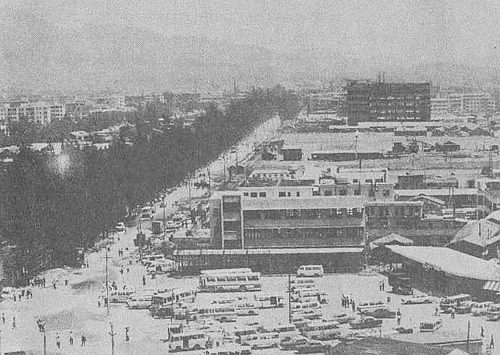|
 |
|
The Luohu commercial area in the Shenzhen Special Economic Zone under construction |
The city of Shenzhen in Guangdong Province is being transformed into one of the largest special economic zones in the world. In August last year, the Chinese Government formally approved it as a special economic zone, which will use foreign capital to produce export goods. Major changes have already taken place.
Large numbers of bulldozers and road rollers are busy working. Hills have been levelled and low-lying areas filled. Some recently completed factories have already gone into operation. Many factories, shops and residential units are under construction. Foreign vehicles speed along the new, but unfinished, roads leading to Guangzhou. Numerous billboards have been erected near bus stations and vital communications lines. Construction of water, electricity, communication and navigation projects is in full swing.
According to present plans, the total area of the Shenzhen special economic zone will cover 327.5 square kilometres (one-sixth of the city). Ninety-eight square kilometres of land will be used for constructing projects, an area two-thirds of the size of Shanghai proper, China's largest industrial city.
The special economic zone is to be divided into five sections. The westernmost end is the Shekou industrial area, which has been placed under the administration of the China Commercial Shipping Corporation of the Ministry of Communications. Thirteen factories are to be built there, two of which will be state enterprises run by the corporation. Three have been financed by foreign merchants and eight others will be jointly operated with Chinese and foreign investments. The Shangbu district in the centre of the city is also an industrial area devoted to electronics, light and textile industries. Another district in the middle of the city is the Luohu commercial area. Plans have been made to build a 20-story International Commercial Centre and a 14-story Luohu Building. Before construction of the two buildings was started and only a few days after an advertisement was published in the newspapers, every floor was rented. A building will be constructed to house the offices of Chinese provinces and cities. Forty-three departments have sent in requests for rented space. The easternmost end of the special economic zone is located on two bays which are to be developed into a tourist area. Another stretch of land will be used for residential quarters. The scenic area near the Shenzhen Reservoir will get a new overseas Chinese settlement. The special zone will also have an economic management college.
A stream of Hong Kong and Macau businessmen, overseas Chinese businessmen and financial groups from developed countries have come to negotiate the setting up of enterprises. From the beginning of 1978 to the end of last June, agreements were reached on 720 projects. The total sum of investments under contract amounts to 2.4 billion Hong Kong dollars (equivalent to about $400 million). During the initial stage, imported foreign industrial processing was limited to projects requiring small investments. Since 1980, agreements have been reached on a number of big projects, 35 of which required investments of 10 million Hong Kong dollars. Seven others required investments exceeding 100 million Hong Kong dollars.
Of the 720 projected projects, 548 have gone into operation. Ninety-five others have started construction, but have not yet begun production.
Agriculture is an important component of the special economic zone. Shenzhen city has 1,600 square kilometres of land in addition to the 327.5 square kilometres planned for the special economic zone. It has approximately 300,000 people engaged in agriculture. Local agriculture will provide vegetables, meat, eggs, fruit, seafood and other sideline products. Efforts will also be made to develop export goods to meet Xianggang's market needs. The zone has set up 20 chicken farms, 2,600 hectares of fish ponds and other production bases.
| 